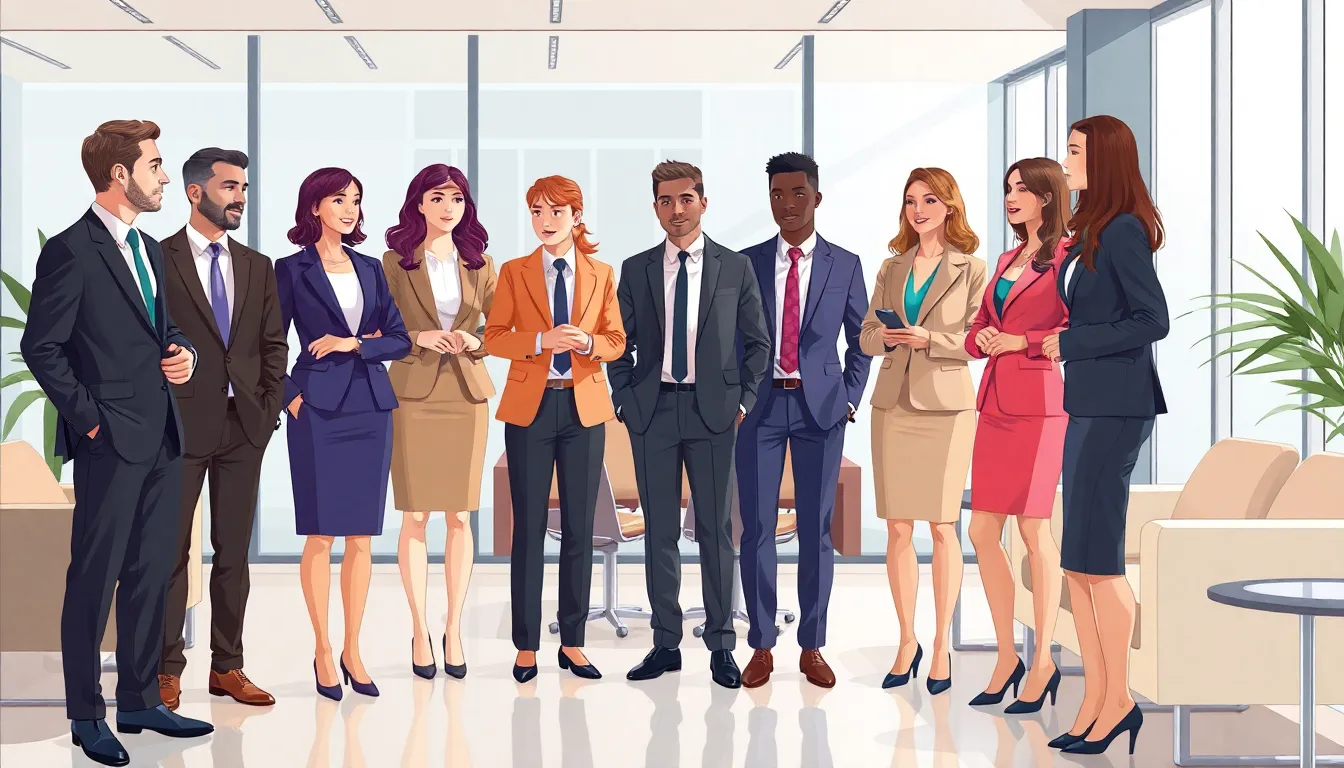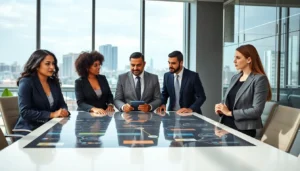Table of Contents
ToggleIn the world of business, first impressions are everything. Imagine strutting into a meeting in an outfit so sharp it could cut glass, while your colleague shows up looking like they just rolled out of bed. It’s a tough gig, but dressing for success doesn’t have to be a chore. With the right business outfits, you can blend professionalism with a dash of personality that says, “I mean business, but I also know how to have fun.”
Importance Of Business Outfits
Business outfits play a crucial role in creating lasting first impressions. Those who dress professionally often convey confidence and competence, which can be essential in networking and client interactions. An appropriate outfit influences how colleagues perceive one’s capabilities and professionalism.
Dressing well promotes a sense of authority, as studies indicate that individuals tend to trust well-dressed professionals more. The clothing choice can also boost one’s self-esteem, encouraging improved performance in various situations. Attire reflects personal brand identity, allowing individuals to express their unique personalities while maintaining respectability.
Fitting into the workplace culture is vital. For example, a suit may be standard in a corporate environment, while smart casual attire might be acceptable in a creative setting. Knowing the appropriate dress code enhances one’s ability to integrate seamlessly into different workplace contexts.
Accessories, such as watches and ties, can complement business outfits and add a touch of sophistication. Colors and patterns further play a role in communicating messages; blue suggests trust, while red can signify power. Ultimately, thoughtful outfit selection conveys respect not only for oneself but also for others.
Attention to detail in attire indicates a commitment to professionalism. Clean, pressed clothing demonstrates responsibility and enhances one’s image. It’s clear that strategic choices in business outfits significantly impact professional relationships and career advancement.
Types Of Business Outfits

Understanding the various types of business outfits can enhance professional presentation and reflect an individual’s personality. Each outfit type serves a unique purpose in the workplace.
Formal Business Attire
Formal business attire includes suits, dress shirts, dress shoes, and ties for men, while women typically wear tailored suits, blouses, and heels. These outfits convey professionalism and are essential for formal meetings, interviews, and networking events. Dress colors tend to be conservative, focusing on black, navy, and gray for a polished appearance. Fabrics like wool or high-quality blends elevate the overall look, ensuring a sense of authority. Attention to fit matters significantly, as well-fitted clothing exudes confidence and competence.
Business Casual Wear
Business casual wear blends professionalism and comfort, allowing individuals to express their style without compromising workplace appropriateness. Men often opt for dress slacks or chinos paired with collared shirts, sometimes skipping the tie. Women may choose blouses, smart dresses, or well-fitted trousers. While jeans can be acceptable, they should be free from rips or excessive wear. Colors and patterns can vary, offering opportunities for personal expression without straying from corporate expectations. This attire suits flexible environments while maintaining a professional demeanor.
Choosing The Right Business Outfit
Choosing the right business outfit requires careful consideration of various factors. The focus should be on fitting the attire to the specific workplace and its culture.
Consider Your Industry
Different industries demand different styles. Corporate environments often necessitate traditional business attire, like suits and tailored blouses. Creative fields frequently allow for more casual and expressive outfits, such as smart casual wear or unique color palettes. Technology sectors may embrace a more relaxed dress code, favoring comfortable yet professional attire like blazers paired with jeans. Understanding the norms can significantly influence dressing choices, showcasing professionalism while allowing for personality.
Dress Code Guidelines
Dress code guidelines offer a framework for appropriate attire. When formal attire is required, men typically opt for dark suits and polished shoes, while women may choose tailored dresses or elegant pant suits. Business casual outfits often involve dress shirts paired with chinos for men and blouses with skirts or slacks for women. Some workplaces adopt a casual dress code on certain days, permitting jeans and polo shirts but maintaining a polished look. Adhering to these guidelines ensures respect for workplace culture and helps individuals align their fashion choices with professional expectations.
Tips For Accessorizing Business Outfits
Accessorizing business outfits enhances professional appearance and reflects personal style. A well-chosen accessory can elevate an outfit and make a strong impression.
Selecting The Right Accessories
Selecting appropriate accessories can significantly impact a business outfit. Focus on minimalism and choose pieces that complement rather than overshadow attire. A classic watch, simple jewelry, or a sleek belt adds sophistication. Avoid overly bold items that might distract from the overall look. Colors should harmonize with the outfit palette, ensuring cohesion. For example, neutral tones pair well with most ensembles while a pop of color can highlight an aspect of the outfit. Aim for functionality; a quality bag can serve both style and practicality.
Footwear Choices
Footwear choices convey professionalism and attention to detail. Select shoes that align with the outfit’s formality; polished dress shoes work well in formal settings, while loafers may suit business casual environments. Women’s options may include heels, flats, or stylish boots, depending on comfort and style preferences. It’s important to consider that well-maintained shoes reflect personal care and responsibility. Neutral colors or subtle patterns enhance versatility, allowing for easier pairing with various outfits. Prioritize comfort without sacrificing style; choosing the right footwear ensures confidence throughout the workday.
Dressing appropriately for the business environment is essential for making a strong impression. The right outfit not only reflects professionalism but also enhances confidence and personal branding. By understanding workplace culture and adhering to dress codes, individuals can navigate their professional landscape effectively.
Accessories and footwear play a significant role in completing a business look, adding sophistication without overshadowing the overall appearance. A well-curated wardrobe allows for personal expression while maintaining respect for industry standards. Ultimately, the choices made in professional attire can open doors to new opportunities and foster valuable relationships in the business world.




